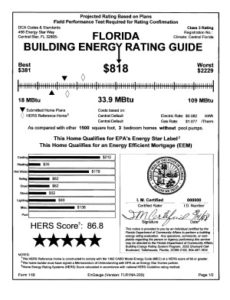FAQs
Frequently Asked Questions for Homeowners
No, unless the house was tested and verified, there is no assurance. Some of EPA’s protocols do not even meet minimum Florida energy code requirements (specifically Building Option Packages)! Also, how do you know if your home is energy-efficient it if has never been tested and verified?
If your house was rated and tested, you should receive a report with your address, signed by a certified Energy Rater, with a signed financial disclosure form. The report looks similar to this:
No, your house may have been “sampled” under one of EPA’s policies. If your house has been sampled, only 1 out of 7 houses in your subdivision may have been actually inspected and tested!
No, Energy Raters Plus services regarding mold is to diagnose the building conditions and analyze the reasons why the mold is present for preventative purposes. Unless those conditions are understood and rectified, there is a high probability that the mold will return. Mold remediators collect samples, identify the mold type, determine the concentrations and sanitize the affected area.
An Energy Rating is a quantitative report that contains as one of the inputs, a duct leakage number. A Smoke Test is a visual method to identify and correct failures in the duct system, without the need to quantify a number. That number will be lower if measured later for an Energy Rating. An Energy Rating tells “how much” with measuring instruments. A Duct Smoke Test tells visually “how much” in addition to “where”.
Nothing. An Energy Rating is a report that is one of the predictors of the energy uses in your house. The true indicator of the energy efficiency of your house is your monthly electric bill. It is hoped that since an Energy Rating has been performed, awareness and implementation of more energy efficient practices have occurred during construction.
When no smoke is detected penetrating the ductwork.
Temperature difference between the air flow created by the smoke testing unit and the outside air. In addition, the infrared camera would require the operator to give verbal directions to the AC technician of where the leaks are located, even if it was possible to locate the failures.
Trust, but verify. If they are so sure that there is no leakage, there should be no problem in verifying the claim. It is a relatively cheap insurance policy that the duct system is smoke tested to be leak-free. In any event, the claim should be questioned, since leakage is invisible even to the best of inspectors.
After all components are installed, it is nearly impossible to access what is the major portion of the distribution system for adequate repairs.
That would largely depend upon how bad the ducts leaked prior to repairing. If there was initially very little leakage, then the savings/payback for the test would be longer. If the the system was very leaky, the payback would be extremely quick. From our experience, a 30% reduction in leakage can be expected. Remember, the test and remediation is performed prior to air handler, insulation, drywall and register installation and any other factors. Even small duct leakages at a long period of time can be significant.
A certificate is issued by a certified duct and smoke tester. To ensure that the system has been tested and sealed by our protocol, the certificate will be signed by Scott Brann.
Just marking the failures doe not guarantee that they will be fixed later or that we can even mark the point of leakage adequately. We require an AC representative on-site, during testing, to immediately repair failures in the duct system.
We do not know how it is possible to address failures by testing only X number out of so many houses. We cannot understand how an energy efficiency label can be assigned to a home that has never been inspected or tested, as some “energy-efficiency” programs do.
We have a word for this practice: F-R-A-U-D.
No, we do not sample homes as it is our experience that the number of failures precludes any possibility of sampling.
California requires smoke testing in change-outs of the HVAC system in certain circumstances, although the process and tools seem cumbersome. The requirement can be found at: http://www.energy.ca.gov/title24/2008standards/changeout/
Good question. Even the AC contractors think that it is a good test because they are called back for complaints, in the summer, to climb into a 135 degree, unlit attic. Building Officials also realize that this is a superior test compared to plain visual inspection. There are many efficiency programs created by numerous entities with their own fiefdom to protect. Some are “energy efficient” in name only with little interest in proactively addressing problems.
No, actually it is not smoke at all, it is theatrical fog…but “fogging ducts” just doesn’t sound cool. Fogging fluid is heated to the vapor point and moved through the duct system at a slight pressure. We have inhaled the stuff with no effects, however we must confess that we have never drank the fluid straight out of the bottle.
Ducts leak…leakage is invisible….smoking is the only method to adequately identify the leakage to address the failures.


